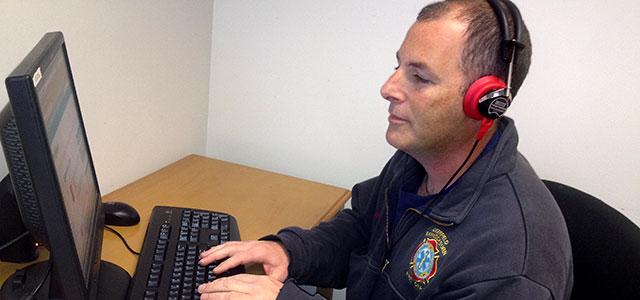
A firefighter participates in internet-based, hearing-loss training.
Electronic Interventions Bridge Nurse-Patient Gaps
Increasingly, computer and television screens provide a way for clinicians to reach patients in exciting new ways. Rather than relying solely on face-to-face interactions to motivate patients to do what they need to improve their health and well-being, nurse researchers are exploring innovative techniques that take advantage of technological advances.
Preserving Hearing for Firefighters
According to nurse scientist OiSaeng Hong, who directs the Occupational and Environmental Health Nursing Specialty at UCSF School of Nursing, approximately one in five firefighters suffer from hearing loss. The reason? Years of intermittent and unprotected exposure to levels of noise that exceed the recommended limit of 85 decibels. (Click here to understand what 85 decibels sounds like.)
“Most firefighters don’t realize it only takes a very short period of exposure to begin hearing loss,” says Hong.
In addition to its impact on their own lives, hearing deficits in firefighters pose serious public safety concerns. Consequently, firefighters must meet certain base levels of hearing competence or lose their job.
For much of her career, Hong has been seeking to help at-risk workers prevent and cope with hearing problems. Her latest project is informed by her belief that ever-improving web-based tools offer an accessible, effective and economic way to educate firefighters about the effects of noise and about ways to protect their hearing.
Hong and her team have developed an online intervention based on behavioral theories and her own prior studies that provide insight into why firefighters don’t always use hearing protection. One significant factor is that they put the public’s safety in front of any concerns they might have about their own loss of hearing.
“Our intervention helps them understand that they are very susceptible to hearing loss and that their loss of hearing jeopardizes public safety,” says Hong. “We believe this will make them more likely to protect their hearing.”
The intervention begins with an in-person audiometric test to help firefighters understand their baseline hearing levels. Then, on their own time, the firefighters participate in an online, interactive training program tailored to the hearing test results. The intervention can be completed from anywhere and is specifically designed for the unpredictable interruptions associated with a workforce that must be ready to drop everything at a moment’s notice.
“We come back at three months to see if they increased the use of hearing protection and then again at 12 months to see if they maintained their behavior,” says Hong.
Improving the Health of Older Adults with Serious Mental Illness
Though people with serious mental illness tend to die prematurely, improved medical care and medications are enabling them to live longer – a direct parallel to the rest of the population. The problem, says UCSF nurse scientist Heather Leutwyler, is that people with serious mental illness also tend to be in poor physical health, a situation that worsens as they age and can dramatically compromise their quality of life.
Leutwyler, whose own work focuses on older adults with schizophrenia, says, “Part of the reason for their premature mortality and high rates of morbidity is that on average these patients spend about 20 hours a day being sedentary. If we can get them to be physically active, we might be able to prevent illness or make it easier to manage.”
Leutwyler studied the barriers to increased physical activity and found that many older adults with schizophrenia live in facilities, without a convenient place to work out – and feel worried about being stigmatized or “stared at” if they leave their facility to exercise.
But after observing the amount of time these patients spend watching TV, it struck Leutwyler that today’s interactive video games might offer a solution. She created a study to examine the feasibility of older adults with schizophrenia engaging with a six-week physical activity program using the Kinect for Xbox 360 video game system. The study also tests whether the patients will benefit from the increase in physical activity.
Leutwyler is pilot testing the program with small groups in three different settings: a locked facility, an outpatient care center and a transitional residential treatment program. Each week patients – most of whom had heard of but never played these games – get to choose a different off-the-shelf video game. Leutwyler and her research staff provide a tutorial and then remain in the room to offer coaching as appropriate.
To date, the most popular video game is bowling. Once they get the technique down, Leutwyler says that nearly everyone has experienced some success and enjoyed the activity.
The combination of success and social interaction may be just the motivation these patients need. Leutwyler says she has seen the groups bond and an “increase in smiles.” She hopes to use a larger study to measure the effect on psychiatric as well as physical symptoms. Studies in younger adults have suggested physical activity can complement psychiatric treatment.
“Most of us have a hard time being physically active, but when you have a psychiatric illness it isolates you and you’re particularly unmotivated, so any kind of movement is a step in the right direction,” says Leutwyler. “To the best of our knowledge, this is the first physical activity program designed for older adults with schizophrenia, and the preliminary data show that the program makes physical activity fun, accessible and social.”



